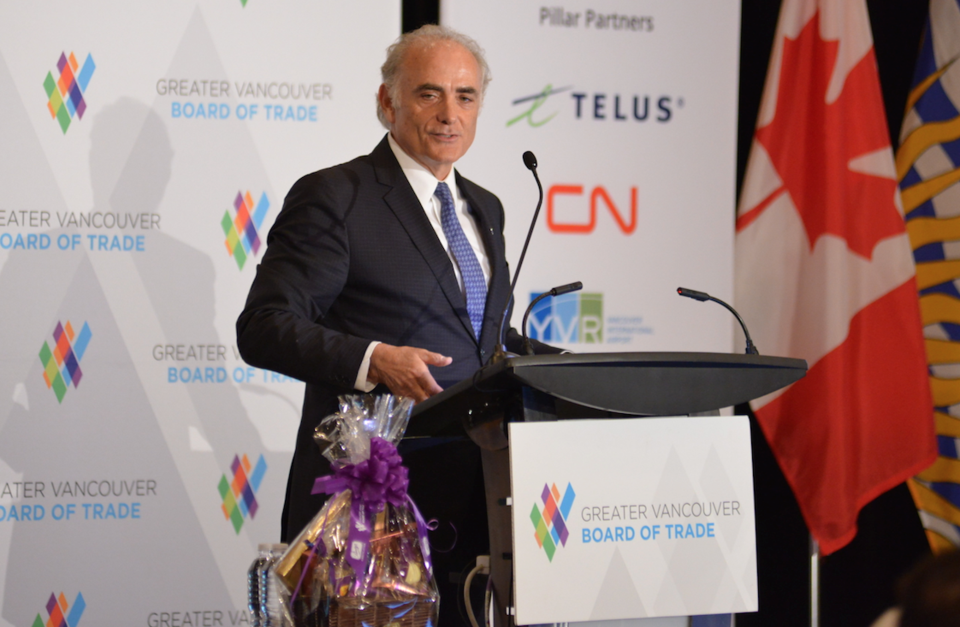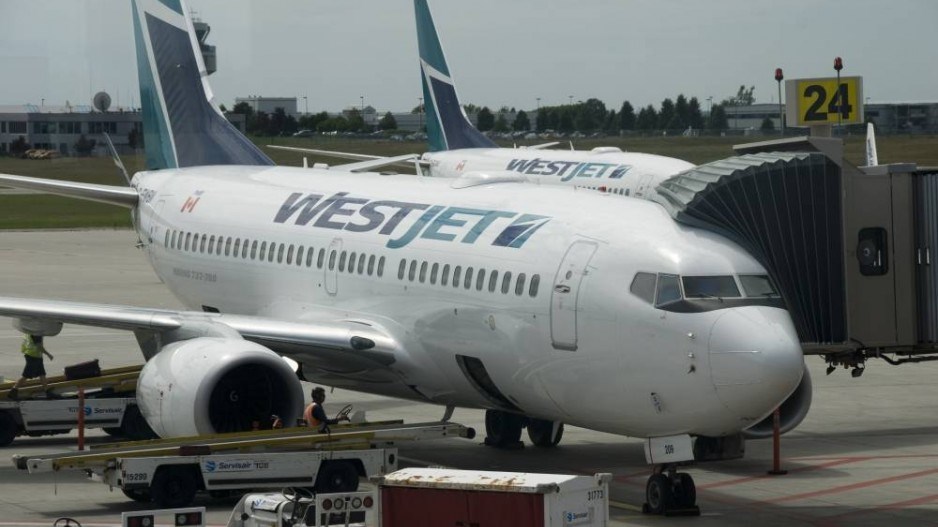Westjet (TSX:WJA) plans to launch a new ultra-low-cost carrier (ULCC) – a secondary brand – before the end of the year as a way to ward off competitors, such as NewLeaf and Canada Jetlines.
The move also aims to follow Air Canada’s (TSX:AC) success at proving that secondary brands need not be a hindrance.
Air Canada CEO Calin Rovinescu described his airline’s secondary brand Rouge as “our lower-cost leisure carrier” in an April 20 speech to the Greater Vancouver Board of Trade and he credited that brand with much of his airline’s recent profitability.
WestJet has yet to name its secondary brand, which will be subject to an agreement with its pilots as well as regulatory approvals, WestJet CEO Gregg Saretsky wrote in an April 20 blog post.
Those pilots, meanwhile, announced hours after Saretsky’s blog post that they are vying to unionize and have filed membership cards with the Canada Industrial Relations Board.

(Image: Air Canada CEO Calin Rovinescu speaks at the Greater Vancouver Board of Trade on April 20 | Matt Borck for the Greater Vancouver Board of Trade)
“There are more than 100 low-cost airlines around the world and there is a relatively new category, called ULCCs, where airlines offer much lower fares with a completely unbundled product offering and increased seat density,” Saretsky said. “This has allowed the traveling public to select what they would like to add onto their ticket, thus keeping the overall cost of travel lower.”
It is unclear how much lower WestJet’s unnamed subsidiary will charge for fares.
Vancouver’s yet-to-launch ULCC, Canada Jetlines, has a business plan where it expects to be able to fly with fares averaging 40% to 50% lower than regular WestJet or Air Canada fares.
Extra fees would apply for everything from carry-on bags to reservations made with credit cards instead of debit cards.
That kind of nickel and diming does not take place on Rouge but Rovinescu said Rouge’s 2013 launch was an important part of Air Canada’s transformation into being a profitable, successful airline after being an on-the-ropes carrier in 2009, reeling from a recent restructuring.
Traditional aviation wisdom had been that full-service carriers could only compete successfully when marketing involved a single brand, he said. Air Canada proved that truism when it experimented with low-cost divisions called Tango and Zip before its 2003-2004 restructuring.
“Rouge is designed to do precisely what it was said could not be done,” Rovinescu said in his afternoon speech. “From the start, it has contributed significantly to our profitability.”
He credited Rouge for enabling Air Canada to maintain or expand leisure routes and enter new international markets in Europe, Asia and to sun destinations.
“It gave us flexibility to move in and out of markets to meet seasonal demand and allowed us to stay in the game in markets we were losing.”
Rouge’s first flights in 2013 were on four aircraft flying 14 routes. This summer Rovincescu said he expects the airline will operate 49 aircraft across a network of 93 routes, touching five continents. This includes two new routes out of Vancouver this summer: to Nagoya, Japan and London’s Gatwick Airport.
As for Jetlines, its executive chairman, Mark Morabito, thanked WestJet for drawing attention to the need for ULCCs.
“We believe that what Canadians need, however, is a genuine ULCC and greater competition,” he said.
“Today's announcement offers nothing more than an ‘airline within an airline’ that will not increase competition into the market, and it remains to be seen whether it will be able to achieve the full benefits of a ULCC. Most ‘airlines within airlines’ that have attempted to offer low-cost options for air travellers have failed in North America, including Zip, Ted, Song, Metrojet, Calite, and United Shuttle. The continent is littered with the graves of these lower-cost airlines, precisely because the model doesn't work when the airline is owned by another airline.”




